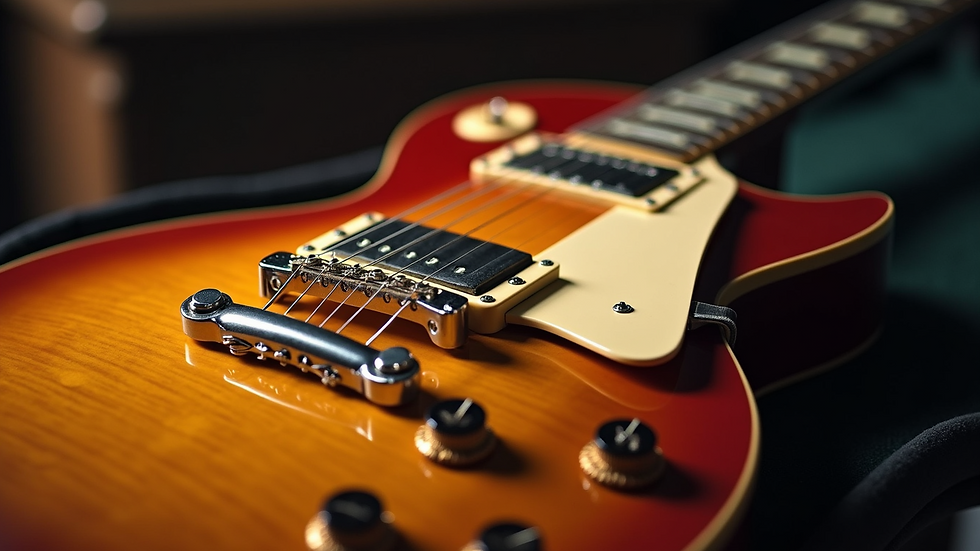The Evolution of the Electric Guitar From Early Innovations to Modern Mastery
- Leonard Flutes
- Jun 5
- 4 min read
The electric guitar is more than just an instrument; it represents significant cultural changes, musical advancements, and technological progress. From the first designs in the 1930s to the innovative models we see today, the electric guitar's journey is filled with groundbreaking developments and iconic brands. This post will focus on key milestones and highlight notable examples that shaped its rich history.
The Birth of the Electric Guitar
In the early 1930s, musicians required an instrument that could compete in volume with brass and woodwind instruments. This demand led to the creation of the first electric guitars. Before this, guitars relied solely on their acoustic sound. Pioneers like George Beauchamp and Adolph Rickenbacker transformed this landscape by introducing the first commercial electric guitar, known as the "Frying Pan," in 1931.
These early electric guitars featured solid bodies and metallic tones, which were a departure from traditional acoustic designs. The Rickenbacker Electro model stood out with its innovative magnetic pickups, which enabled musicians to amplify their sound like never before. By 1935, these innovations allowed musicians to reach audiences in larger venues, changing performance dynamics.
The Rise of Iconic Brands
As the electric guitar gained traction, major brands emerged and played pivotal roles in defining modern music.
Gibson
Gibson made a significant impact in 1936 with the introduction of the ES-150, the first electric guitar to achieve commercial success. Jazz guitarist Charlie Christian popularized this model, demonstrating its capabilities. Fast forward to the 1950s, Gibson introduced the Les Paul, which became synonymous with rock music. It is beloved for its rich tones and sustain, making it the choice of legends like Eric Clapton and Jimmy Page.

Fender
In the 1950s, Fender revolutionized the electric guitar market with the Telecaster and Stratocaster. The Telecaster, recognized for its bright, cutting sound, quickly became a favorite among country musicians. The Stratocaster, noted for its contoured body and versatility, rose to fame with rock icons like Jimi Hendrix, who used it to break new ground in guitar performance and sound.
Fender prioritized innovation, introducing features like the tremolo system and diverse pickup configurations. By the end of the 1950s, Fender's instruments had established themselves as standard tools in various music genres.
Technological Advancements: From Tubes to Transistors
The journey of the electric guitar closely aligns with significant technological developments. The introduction of solid-state amplifiers in the 1960s and 1970s changed the musical landscape. These amplifiers were lighter and more efficient, thanks to transistor technology, allowing musicians to transport their gear with greater ease. Studies showed that solid-state amplifiers could provide reliable sound quality while reducing weight by up to 60%.
Despite these advancements, many purists still preferred classic tube amplifiers for their warm sound. This ongoing debate illustrates the guitar community's tension between traditionalists and innovators, demonstrating that both technologies can exist harmoniously.
The Digital Revolution and Diverse Soundscapes
The electric guitar underwent a significant transformation during the digital revolution of the 1980s. This era introduced digital effects processors and modeling amplifiers, unleashing a level of creativity that previously seemed unattainable. Brands such as Line 6 and Boss gained popularity for their products that allowed musicians to emulate vintage sounds and explore new musical territories.
This period witnessed the emergence of genres like grunge and metal, both heavily reliant on electric guitar tones. For example, Nirvana's "Smells Like Teen Spirit," influenced by heavy distortion, highlighted how versatile electric guitars could express raw emotions.

The Customization Era
The 2000s saw a surge in guitar customization, with musicians seeking personalized instruments that matched their style. Brands like PRS and Music Man struck a balance between fine craftsmanship and large-scale production. This shift allowed players to choose materials, colors, and even pickup configurations tailored to their needs.
Boutique builders also gained traction, focusing on handcrafting electric guitars with unique aesthetics and sounds. Musicians increasingly valued these artistic offerings, recognizing the significance of individual expression in their instruments.
The Electric Guitar in the 2020s
As we progress through 2025, the electric guitar continues to adapt while celebrating its extensive history. A growing emphasis on sustainability has prompted brands to incorporate eco-friendly materials into their production processes. For instance, some companies report using up to 30% less plastic in their products through innovative design.
On the technology front, modern guitars now include features such as Bluetooth connectivity and integrated effects, offering musicians unprecedented versatility. Players can explore a multitude of sounds without carrying a cumbersome pedalboard, resulting in a heightened level of creativity during performances.

A Lasting Legacy of Innovation
The electric guitar has transformed significantly since its origins in the 1930s. Its journey reflects the creativity, innovation, and artistry of musicians across decades. Each brand, from Gibson to Fender and beyond, has made a lasting impact, shaping the electric guitar's sound and design.
As we move into the future, the electric guitar remains a vital tool for expression and innovation. Its ability to embrace changing technologies while staying true to its roots ensures its status as a beloved instrument for generations to come. The evolution of the electric guitar serves as a powerful reminder of creativity's ability to shape our world through music. Whether you are a dedicated musician or an enthusiastic fan, this journey highlights the beauty and complexity of artistic expression.




Comments